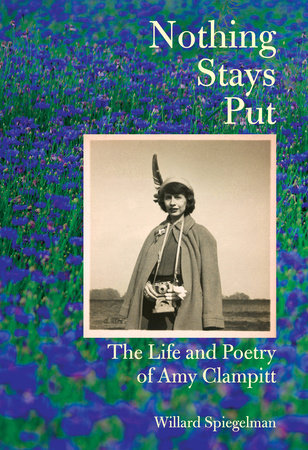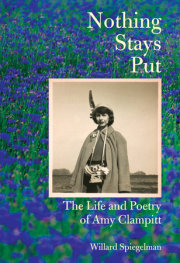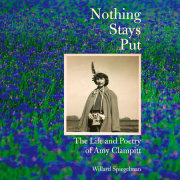Iowa
To someone who peers out from the window of a plane descending into Des Moines, the state capital, Iowa in mid-June can look Ireland-green, especially after a late, wet spring. Heavy rain has made the soil sodden. It has delayed the planting season. The landscape is “plotted and pieced,” as Gerard Manley Hopkins would have called it. The predominantly rectilinear fields are neatly geometric, with alternating quilt-like blocks of green and brown, as though Cézanne had painted them. Occasionally, roads break through the boxy squares on a diagonal. And one also sees from above some meandering rivers and streams, refusing to be controlled or contained.
Like those streams, Amy Clampitt refused to be contained. She would not stay put.
Her birthplace, New Providence, appears pretty much the same today as it did a little more than a century ago when she was born. The population, approximately 200, has remained steady. Small and medium-sized farms here still rely primarily on family members, many of them with agronomy degrees from Iowa State University in Ames, forty-two miles away, to do the work. Seasonal help is not really needed. New Providence Hardware, Iowa’s oldest hardware store (est. 1863), along with several other modest shops, stands on Main Street. Inside, there’s a wall plaque that bears the slogan of an 1882 temperance campaign: “A schoolhouse on every hilltop, and no saloon in the valley.” The brag still remains a living truth, at least in part. “Neither a tavern nor a saloon has ever existed within the borders of New Providence,” the plaque continues, although the schools have long since been consolidated with others in deep red Hardin County. Among several claims to fame, New Providence boasts the residency of Mildred (Ghrist) Day, who attended a one-room school here, and invented the Rice Krispies Treat in 1939. Nearby is Eldora, the county seat. This was the birthplace of another Iowa poet, Clampitt’s contemporary who was for years much better known, Mona Van Duyn (1921–2004). And here, as in other small rural towns in the county, many houses abut fields and farms, not backyards. This is not suburbia. Everything is green to the very door.
It was into this community and a family of self-reliant, pacifist, literary and intellectual Quaker farmers that Amy Kathleen Clampitt was born on June 15, 1920, the year that American women—courtesy of the Nineteenth Amendment to the Constitution—were granted the right to vote. Her life was shaped by the major events of the twentieth century: the Depression, World War II, postwar prosperity, and then the unleashing of political unrest in the wake of the civil rights movement. She belongs to that century. And she also belongs to Iowa. Many things have changed in her native terrain, but much has remained the same in farm country. She would surely recognize the place today.
When I visited in June 2019, it was unclear whether there would be enough sun and warmth to guarantee a good autumn crop. For farmers, there is nothing to do but wait and see. They have suffered worse. They have inherited or developed patience. They know that human effort can go only so far. After that, one relies on larger forces, perhaps on divine grace.
New Providence residents, like people everywhere who are of the land, tend to be straightforward, unironic, but verbally adroit when they choose to be. Farmers are conservative in the best sense. They are vigilant, circumspect, frugal, and self-protective. Asked about their reactions to weather, economic changes, governmental policy, tariffs, and taxes, one man repeated what he said was a standard, because true, adage: “Farmers always suffer first, suffer hardest, suffer longest.” A fact of reality.
There’s a paradox in small-town life: people seem to mind their own business, but there can be no privacy where everyone knows everyone else, and everything about the community. As Willa Cather, wedded to but separated from Nebraska, understood, there’s no hiding on the prairie. And local history always runs deep. Late in her life, Amy referred to this paradox as “the mentality of townships, where there is no getting away from being known about and, ipso facto, classified.”
In an interview with the novelist Jean Hanff Korelitz, she made her point more harshly. She was labeled from the beginning as someone who did not quite fit into the place she called home: “Everybody who is ambitious is called selfish . . . that’s the term for somebody who goes off someplace . . . I was a misfit from the start.” How did this come about? For one thing, when Amy entered school she already knew how to read and write; she became isolated—in her memory—and had no friends. An early grade school teacher thought she was showing off. She skipped a grade. At the same time, she “realized that life at home was fraught with something I didn’t really understand. My parents were both feeling very frustrated about being where they were. And you absorb that. I didn’t have exactly a carefree childhood.”
Looking back, she allowed that by the time she’d reached adolescence she had also begun to refuse standard roles, a refusal that came to dominate her social life as a career woman in Manhattan in the 1940s and ’50s:
I thought I had to know how to keep house. It wasn’t that I didn’t want to get married, I just didn’t exactly want to get married, so I always managed to be connected with unsuitable people who were already married or something. It was as if I played a sort of trick on myself to keep from settling down. I know other women who have done that, although they will say that they’re very sorry not to have had a child. This is something I never was interested in. I knew very distinctly from the time you first talk to people about what you’re going to do that I didn’t want to have children. I knew that. I just saw that it was such a drag and I knew I wouldn’t be a good mother and that’s one thing that’s always been clear to me all my life.
She sort of wanted to get married; she sort of did not want to get married.
And with regard to offspring, from all reports about Amy as an adult, as an aunt (“Amy Aunt”—not “Aunt Amy”—as her brother Larry’s children always called her, with an appropriate quirkiness) she was a fairy godmother, a combination of big sister, Dutch uncle, and bohemian host. She was something of a midwestern Mame Dennis. She said that after the bomb fell on Hiroshima she did not want to bring children into the world. But she adored and was adored by children. Her nephew Peter, second son of Larry and Jeanne, recalled that when they got to be twelve, he and his siblings would each be treated to a visit with their “hippie” aunt in Manhattan. For him, a fledgling drummer, the trip included a visit to the Five Spot on St. Mark’s Place to see jazz legend Art Blakey. Amy Aunt knew exactly what would give pleasure, excitement, and a momentary escape from the conventional suburbs of Boston. At forty-five, she thought nothing of climbing to the top of the Statue of Liberty—354 steps, twenty stories—with her nephew. The writer Cynthia Zarin, a friend during Amy’s final years, recalled taking her two-year-old daughter on picnics in the park with Amy, who had made dolls for the toddler: “She was like a fairy.”
Paradoxes seldom go away. They multiply. In a late poem, “Homeland,” Clampitt, now advanced in age and confident in her poetic craft, looks back, with what begins as nostalgia, to the apple trees—and their crop—that dotted her Iowa farm. The poem is rich in details borrowed in part from John Keats’s “To Autumn” and Robert Frost’s “After Apple-Picking.” And it offers a reminder that in Amy’s midwestern landscape, an orchard of apple trees offered protection against the elements: it was a “windbreak” and a “shelterbreak.”
Harvest and fall come not only with the fulfillment of nature’s bounty but also—here’s the turn—with the menace we might associate with the ghouls of Halloween:
. . . out there the old gods
slithered and swam uncaught,
and though we knew that no one
knew when one of them might next
flatten a crop or set a barn afire,
or worse, the bagged winds’ black
archangel, even, had no proper name.
Homelands possess unease, forebodings, and their own “black / archangel.” The apple bin contains the peculiar “long-dormant resonances / of an oncoming winter.” The farmer knows the grim truth: destruction is always possible. The sensitive child can feel the chill of weather, and of an internal climate as well. She remains both in and not quite part of her family, her community, her landscape.
Outcast in one way, in others Amy was known and classified, boxed in like the landscape. Her great-grandfather Thaddeus Clampitt (1835–1912) had come to Iowa, an illegitimate child, from Indiana in 1859. New Providence had been settled earlier in the decade by Quaker farmers from North Carolina who were unwilling to live in a slave state. Latter-day family members told me that their forebears were also smart enough to realize they could not compete with southern slaveholders on large plantations. They had business sense as well as moral principles. Amy’s grandfather Frank (1860–1943) wrote a memoir when he was seventy-two describing with clarity and common sense what life on the farm was like. Her father, Roy (1888–1973), did the same.
Amy lived, successively, on two family farms, one of which is still in family hands—the first until she was ten, the second until she left home for college at her father’s alma mater, Grinnell. She left again, for Manhattan, following her 1941 graduation, but returned home dutifully and frequently to visit family. She considered herself a New Yorker for the rest of her seventy-four years, although she never felt quite at home anywhere. But it was Iowa, as well as determination, character, and genetics, that made her. And the genetic inheritance from her grandfather and father included strong doses of independent thinking, literacy, and occasional depression, manageable and seemingly modest by today’s standards.
Frank Clampitt privately published Some Incidents in My Life: A Saga of the “Unknown” Citizen in February 1933. He describes the drudgery of farm work with an acknowledgment of Hamlin Garland’s A Boy’s Life on the Prairie as an inspiring predecessor. By his own admission he was “a nervous, sensitive lad” who at fifteen or sixteen suffered “a period of spiritual depression and gloom,” which, after he mentioned it to his parents, disappeared on its own. Life before psychopharmacology seems inconceivable today. Skeptical readers may laugh at the immediacy of a self-help cure, but there it was, just as John Stuart Mill, earlier in the nineteenth century, had talked himself out of an existential crisis by reading Wordsworth. For Clampitt, “the load was gone!—and a certain lightness, a buoyancy, a radiance filled my being.” “Gone,” yes, but not permanently. That buoyancy did not last forever.
Frank’s decision to spend time in college—unusual for a farm boy—came from and led back to a bookishness that continued to offer sustenance throughout his life. His youthful reading included the essays of Bacon, Lamb, and especially Emerson, Whittier’s Snowbound, poems by Sir Walter Scott, and Longfellow’s Tales of a Wayside Inn. Moving into a new house, the young man was thrilled with an upstairs library, which contained “a large walnut bookcase and little desk.” Everything seemed sumptuous compared to the previous house: “this room with its magazine tables, its single bookcase, and dictionary stand was to my book-obsessed fancy a veritable literary paradise.”
Reading inspired writing: “I later practiced composing sonnets as I guided my plow through the long stretches of prairie sod . . . I wrote sonnets to the lark trilling its morning song from a fold of sod near-by.” Consider “Voices of the Wind,” an Italian sonnet whose octave is:
I sit alone within this cotter’s door,
While whispering round it comes the lonesome wind,
Breathing in cadences though undefined
A story I have heard, oh! oft’ before.
Its tone suggests to me a mystic lore
Sublimely wild and sad; there crowd my mind
Vague fancies of Aeolian harpings, twined
With weird oaks’ murmurings on the Epirian shore.
This is a schoolboy’s studied, formulaic effort, amateur but honorable. Still, even at a time and in a culture that prized verse-writing, most ploughmen did not write sonnets. A heartfelt poem, even if trite, stands out.
The need for bodily labor to offset his depressive spells led Frank to drop out of college after a year. He taught school for a while, and then returned to the farm but remained unsatisfied. Thinking to try his hand at other vocations, he moved to California (where Roy was born), but found Pasadena dusty and barren compared to Iowa. So he came home, but his headaches and “nervous dyspepsia” resumed. He discovered that he actually liked farming, especially the business management part of it. Until the end, he maintained a farmer’s frugality, but he also remained extravagant with regard to books.
In 1906, he was again threatened with a nervous breakdown, headaches, low spirits, and “gloomy foreboding,” but he strove to remain useful for his final thirty-seven years. Apparently he succeeded. For the rest of his life, he lived with his ailment, whatever we might label it today. Steadfastness, seriousness, and commitment—what used to be called Yankee virtues—are in evidence on every page of his memoir, as is shyness with regard to self-analysis or confession. When his best and oldest friend lay dying, Frank wrote him a letter “in which I tried to say some things his life had meant to me which natural reticence would have prevented my ever saying to his face.” Intimacies are acknowledged but neither defined nor explained. What was their relationship like? Mutual respect, passion tamped down? Like his granddaughter much later, he said some things, and he remained silent about many others.
The impulse to write never abandoned him. In the summer of 1923, he made an automobile trip west, camping out with his wife. Merely driving along small, dusty rural roads in a rattling car constituted an adventure in itself. He recorded the details, just as, decades later, his granddaughter, having inherited the desire to describe traveling adventures, but with far greater gifts to do so, meticulously recorded her vacations, explorations, and treks in Europe and the States.
Amy inherited as well her grandfather’s agnosticism and—sometimes but not always—his reluctance to belong to anything. In a chapter called “Matters Religious and Spiritual,” he admits that he was never much of a joiner and was uninclined to be churchy. He had, however, a devotion to a greater spirit. He uses the word “evolution” to describe the human urge “to something higher.” Amy, too, felt an aspirational principle. It would lead her briefly to the rituals and practices of High Anglicanism, but she ultimately rejected these, replacing them with political engagement, and then the full-fledged satisfactions of a literary life, which her grandfather neither desired nor attained.
Copyright © 2023 by Willard Spiegelman. All rights reserved. No part of this excerpt may be reproduced or reprinted without permission in writing from the publisher.













